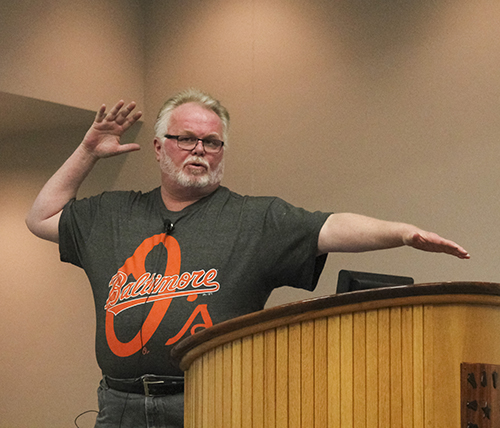
Kirk Bloodsworth speaks to students and community members about his experiences and upcoming book.
(WITH VIDEO) — “It could happen to anyone,” Kirk Bloodsworth, program officer for “The Justice Project,” said as he spoke at the Freed Curd Auditorium Nov. 14.
Bloodsworth became an advocate for DNA testing and abolishing the death penalty after he spent more than eight years in jail for a crime he didn’t commit.
Bloodsworth’s life was just beginning in 1984. He was engaged and moved to Baltimore, Md. He had lived there less than a month when policemen came knocking on his door and arrested him for killing and sexually assaulting 9-year-old Dawn Hamilton.
“I had never thought about the death penalty much in my life,” Bloodsworth said. “I was a commercial fisherman on the Eastern Shore. I had never been arrested in my life. I was an honorably discharged Marine with no record or criminal history.”
He was convicted when a witness drew a photo of Hamilton’s killer. The police ran the photo, plastering it on newspapers and televisions. That was when Bloodsworth’s neighbor believed she recognized him in the photo. She told the police, and Bloodsworth was arrested and taken to court.
“I told anyone and everyone that I was an innocent man,” Bloodsworth said. “I used to sign letters that way. I would say respectfully submitted, Kirk Noble Bloodsworth, A.I.M: An Innocent Man.”
Bloodsworth said there were a significant number of suspects in the case. This was because the witnesses, two 8 to 10-year-old boys, saw Dawn’s murderer in the dark. Therefore, it was difficult for them to make out any facial features or distinct characteristics.
The trial lasted several years. Finally, Bloodsworth was found guilty on all charges and sentenced to death.
“When the gavel came down on my life, the sentence was death,” Bloodsworth said. “The courtroom erupted in applause. ‘Give him the gas and kill his ass,’ is what they said.”
After the sentence was announced, he was sent to a penitentiary where he would serve his time until he would be put to death.
“I was taken to one of the most notorious penitentiaries in the country, the Maryland Penitentiary, where a guard was recently disemboweled by one of the inmates.”
Bloodsworth said he had to come to terms with the fact that this would be his new home, and he would have to make the most of it while he could. He made acquaintances at the prison and strengthened his faith through books.
He worked in the library at the penitentiary where he spent a lot of his day reading. One particular book stuck out to him. It was a book about a murderer who took a DNA test, which, in the end, proved his innocence.
DNA testing for criminals began in 1984. The phenomenon was only beginning to surface during the time that Bloodsworth was in prison.
After he read about the test, he immediately requested to call his lawyer to allow him to take the test. Bloodsworth’s lawyer agreed to give him the test, and his innocence was proven.
“I was the first person in the United States to be freed by post-conviction DNA testing from a capital conviction. That was June 28, 1993,” Bloodsworth said.
Since then, Bloodsworth has become a member of Witness to Innocence, an organization for death row survivors and their families.
The organization strives to make death row survivors leaders by telling their stories across the U.S. and encourages people to help abolish the death penalty.
Bloodsworth’s story has inspired a book called “Bloodsworth: The True Story of One Man’s Triumph over Injustice” and a documentary called “Bloodsworth – An Innocent Man” that will be released in the spring.
Story by Madison Wepfer, Assistant Features Editor
– Video produced by Josiah Brand